9 Best Native Plants for California
BY LAUREN BRYANT | JUNE 6TH, 2023 | CALIFORNIA, LAWN CAREHumans and plants alike love sunny California. But what plants like the Golden State best? Your garden will thrive if you use native plants instead of non-native plants. Vegetation originating in this state is more likely to be
- Low maintenance
- Drought tolerant
- Fire resistant
- Beneficial for the ecosystem
- Pollinator-friendly
Different plants will do well in different parts of the state. For example, a plant that thrives in Northern California may not do well in the Southern California heat. Many plants that grow on the coast won’t do well inland, and vice versa. Let’s review the best native plants for California, including what areas they’re best suited for.
In this article, we will cover:
- 9 Best Native Plants for California
- How to Choose the Best California Native Plants for Your Landscape
- FAQ About California Native Plants
- When to Hire a Pro
9 Best Native Plants for California
This state is home to thousands of plants. Out of those, we’ve selected some popular choices that work for many different areas. Make sure to double-check whether each plant you’re interested in grows well in your city.
1. California Buckwheat (Eriogonum fasciculatum)
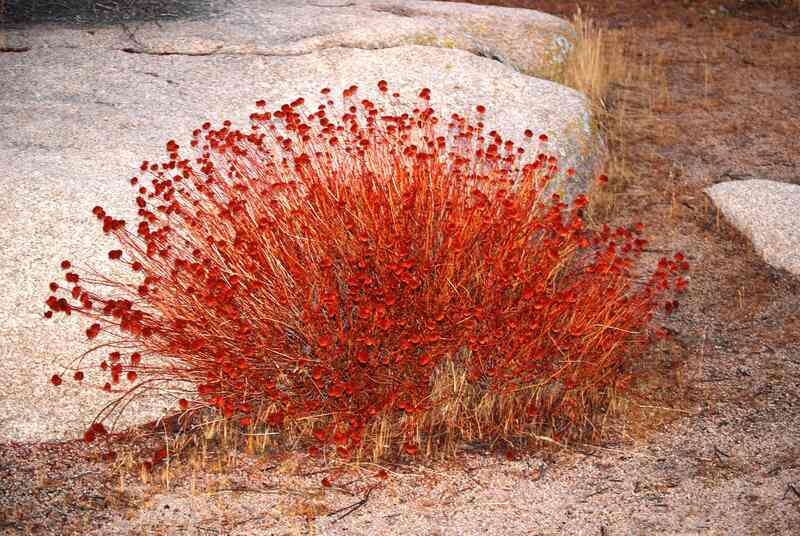
Photo Credit: Jarek Tuszyński / Wikimedia Commons / CC BY-SA 3.0
If you live in Southern or coastal California, consider California buckwheat. This plant grows on scrubby slopes, chaparral biomes, and dry washes. Its structure tends to be more compact in coastal areas and spread out in foothills. You can use some varieties as groundcovers. It produces clusters of leaves and small pink and white flowers from spring to fall.
California buckwheat attracts honey bees, butterflies, and other wildlife. It will shed its flowers and some (but not all) leaves in the dry season, creating a natural mulch. It’s low-maintenance and requires little irrigation once established. California buckwheat may also prevent erosion.
This plant isn’t common in most of Northern California and the Central Valley. It isn’t suited for poorly-drained soils or temperatures below 15 degrees Fahrenheit.
Growth habit: Shrub
USDA Hardiness Zone: 7-11
Mature size: 1 to 6 feet tall and 3 feet across
Duration: Perennial
Foliage: Evergreen
Sunlight needs: Full sun
Soil preferences: Loamy, well-drained soils with a pH between 5 and 8.5
Water needs: Extremely low
Potential hazards: Non-toxic
2. California Fuchsia (Epilobium canum)
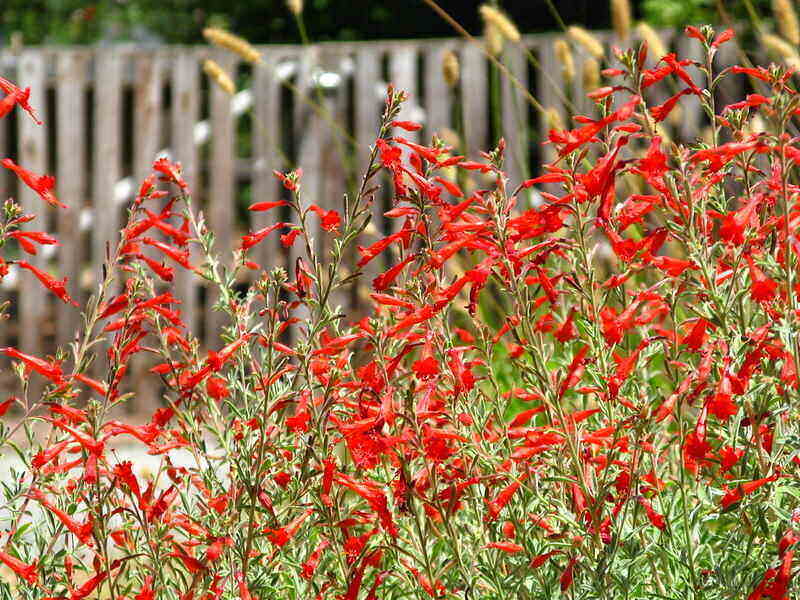
Photo Credit: chuck b. / Flickr / CC BY 2.0
Also known as hummingbird flower or trumpet, the California fuchsia is found in foothills and coastal areas throughout the state. This plant is less common in the central valley and desert regions. It naturally grows near creeks and springs. Use it in gardens or as a ground cover.
California fuchsia produces bright red flowers from summer to fall that attract hummingbirds, butterflies, and moths. Their late summer blooms are particularly notable since many plants are past their peak by then. This species is easy to grow and able to reseed itself. It is also featured on many fire-resistant plant lists.
Though California fuchsia requires little supplemental water in the north, it will need some irrigation in southern and inland areas unless it is close to a wet area. If you live inland or in SoCal, water once a month to keep it alive. The plant may look less aesthetically pleasing once flowering is done in fall or winter. Cut back after the flowering season to improve its health and appearance in spring.
Growth habit: Herb
USDA Hardiness Zone: 7-10
Mature size: ¼ to 1 ½ feet tall and 2 to 3 feet wide
Duration: Perennial
Foliage: Winter semi-deciduous
Sunlight needs: Full sun or partial shade
Soil preferences: Clay and sand with a pH between 6 and 8; they also tolerate serpentine soils
Water needs: Very low
Potential hazards: Non-toxic
3. California Poppy (Eschscholzia californica)
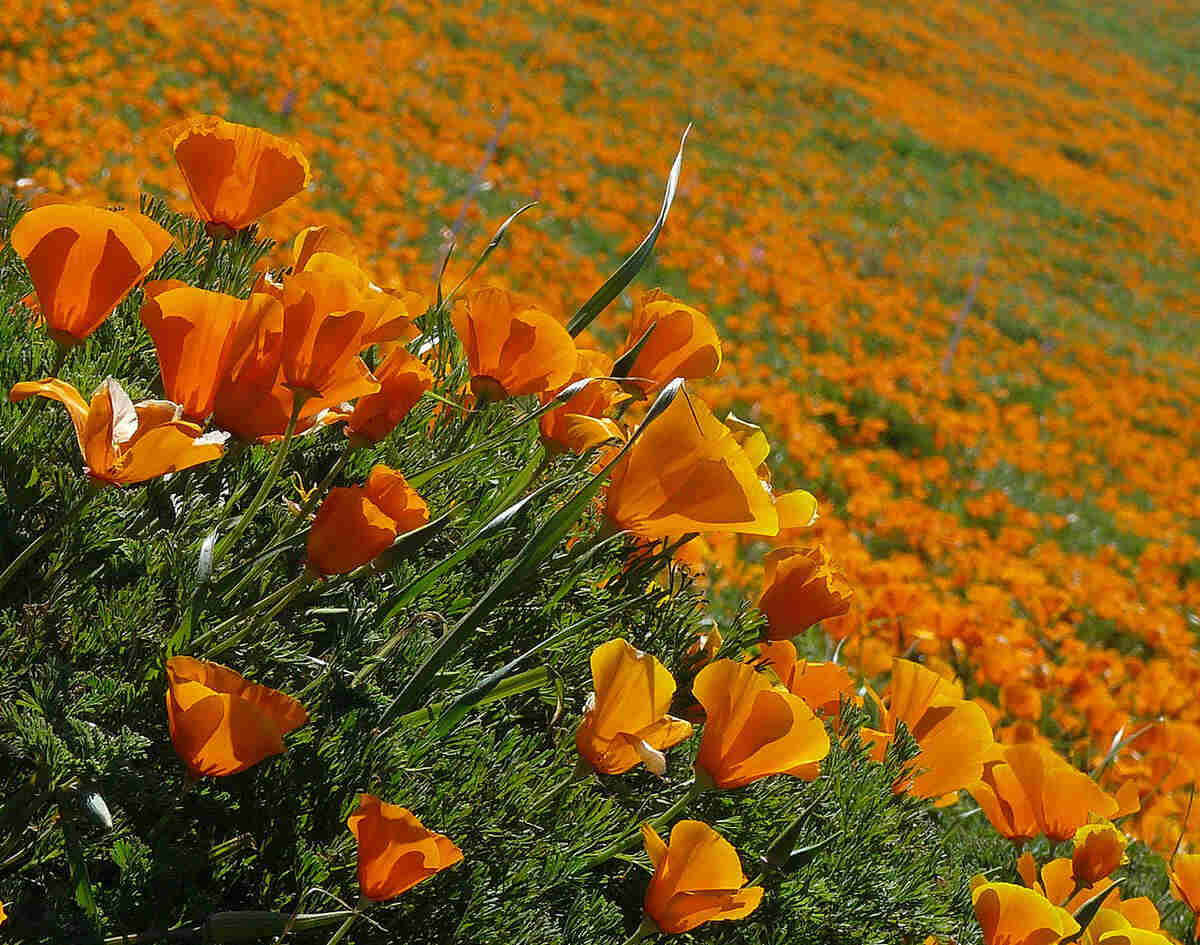
Photo Credit: Epibase / Wikimedia Commons / CC BY 2.0
Most California residents have beheld the beauty of the California poppy, the state’s flower. You can find them in fields all over the state, excluding altitudes above 6,500 feet. They have pale green foliage and orange or yellow flowers. California poppies bloom between February and September, though they close at night and during cold, windy, or cloudy weather.
California poppies are fast-growing and drought-tolerant. Water them twice a month at most in summer to keep them healthy and extend their blooming season. These flowers attract pollinators, birds, and small herbivores. You can easily collect and plant the seeds or let the flowers reseed naturally.
Though they have a long flowering period, they may bloom less in areas with extreme weather. California poppies are edible yet mildly toxic, depending on the consumer, amount, part eaten, and time of year. As a result, there may be better choices for parents and pet owners. Poppies can become a weed due to their rapid growth.
Growth habit: Herb or flower
USDA Hardiness Zone: 6-10
Mature size: 2 inches to 2 feet tall and 1 to 2 feet wide
Duration: Perennial in mild climates and annual in harsh conditions
Foliage: Summer deciduous
Sunlight needs: Full sun or partial shade
Soil preferences: Well-drained sandy soils; tolerates poor soil quality
Water needs: Very low
Potential hazards: Mildly toxic if ingested
4. California Sagebrush (Artemisia californica)
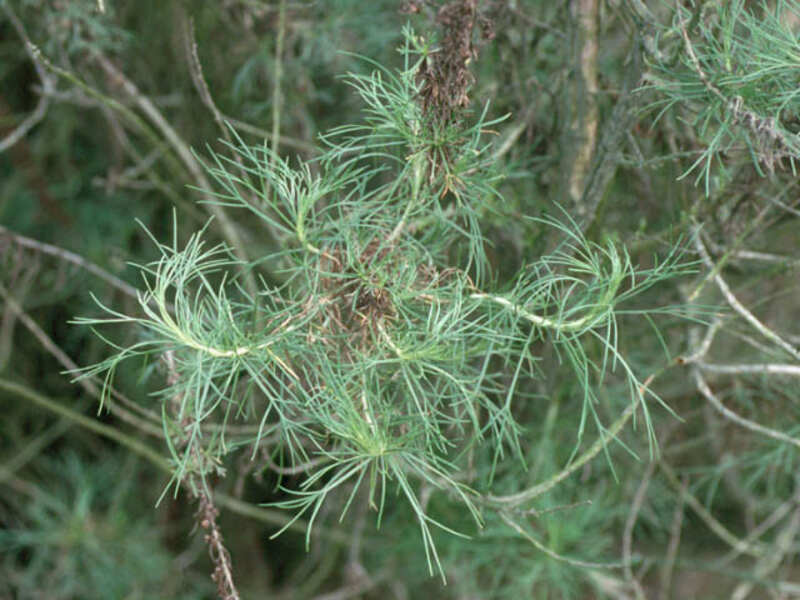
Photo Credit: NatureShutterbug / Flickr / CC BY 2.0
The California or coastal sagebrush is an aromatic shrub found on the coast and foothills. The branches spread out from the base of the plant, creating a round shape. Some varieties work as groundcovers. The leaves are thin, branching, and grayish-green in color. It produces white or yellow flower clusters in spring, summer, and fall.
California sagebrush attracts the California gnatcatcher, a threatened bird species that eats small insects. The plant also appeals to quails, insects, reptiles, amphibians, and small mammals. This fast-growing shrub grows in dry areas where other plants perish and only needs water once a month in summer. Use it for erosion control on sloped properties.
The Cahuilla and Chumash Native Americans historically used California sagebrush as medicine. Though there are no reported dangers for humans, toxins in the plant leech out during the rain and prevent other plants from growing below it. California sagebrush doesn’t tolerate temperatures lower than 20 degrees Fahrenheit, so it’s best for coastal or Southern California.
Growth habit: Shrub
USDA Hardiness Zone: 7-9
Mature size: 1 to 8 feet tall and 4 feet wide
Duration: Perennial
Foliage: Summer deciduous
Sunlight needs: Full sun
Soil preferences: Dry, sandy soils with a pH of 5 to 8; tolerates low fertility and clay soils
Water needs: Extremely low
Potential hazards: Some toxicity towards other plants, but no known danger to humans or pets
5. Common Yarrow (Achillea millefolium)
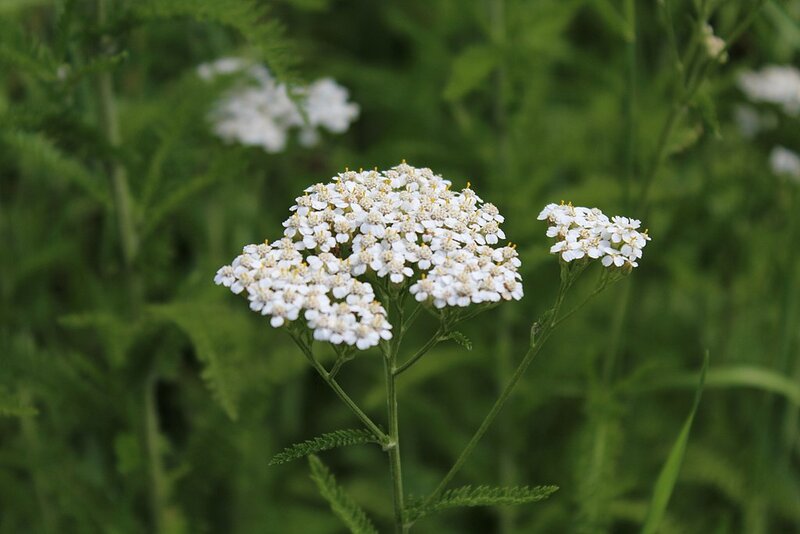
Photo Credit: Jitaeri / Wikimedia Commons / CC BY-SA 4.0
This plant has a dozen different names, including thousand-leaf and plumajillo. It naturally grows in the grasslands and open forests of Northern, Central, and Coastal Southern California. Common yarrow actively grows in spring and produces white or yellow flower clusters from mid to late spring.
Butterflies, bees, and other insects are drawn to this fragrant plant. It’s easy to grow and needs water once a week at most in summer. Common yarrow tolerates sun and shade, making it a good fit for many yards. It can also survive temperatures as low as -15 degrees Fahrenheit. Use it for erosion control or as a ground cover.
Because it reseeds itself easily, common yarrow can spread aggressively. Native Americans used it to stop bleeding, reduce fever, and lessen pain. However, be aware that it is toxic to animals and can cause photosensitivity and rashes in humans.
Growth habit: Herb
USDA Hardiness Zone: 4-8
Mature size: 1 to 3 feet tall and ½ to 1 ½ feet wide
Duration: Perennial
Foliage: Evergreen, summer deciduous, summer semi-deciduous
Sunlight needs: Full sun, partial shade, or full shade
Soil preferences: Any as long as it’s not excessively moist; ideal pH is between 4 and 8
Water needs: Low
Potential hazards: Toxic to animals; may cause rashes or photosensitivity in humans
6. Hummingbird Sage (Salvia spathacea)
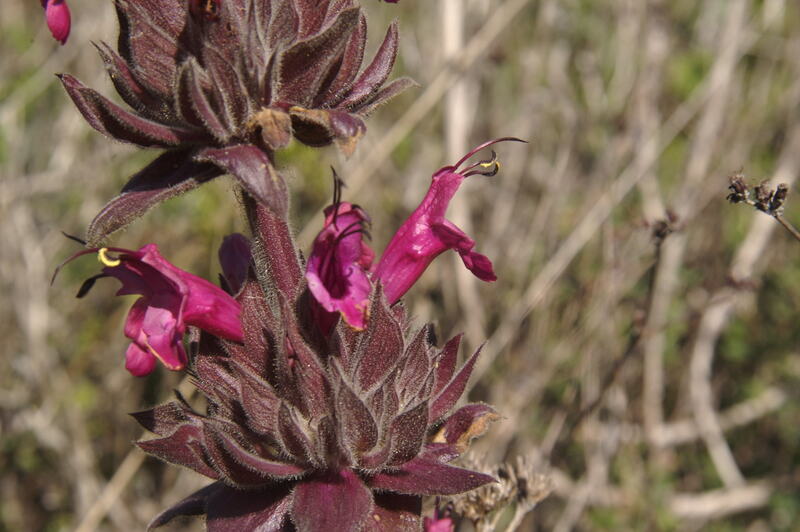
Photo Credit: Jerry Kirkhart / Flickr / CC BY 2.0
Hummingbird sage has upright stems that produce magenta flowers. It blooms from March to May. Its bright green leaves are slightly hairy and produce a pleasant aroma when touched or crushed. The plant is native to Southern and Central California, primarily along the coast and foothills. Cultivars include ‘Topanga’ and ‘Sunrise.’
You guessed it — this plant is great for hummingbirds, butterflies, and bees. Hummingbird sage is a popular choice for gardens and groundcovers. It tolerates anything from full sun to full shade. You likely won’t need to water it at all in summer, though it may lose some leaves. Irrigate hummingbird sage a few times a month to keep it green all year.
Keep in mind that without its tall flower stalks, it will look shorter outside of the flowering season. Hummingbird sage has a limited range compared to other plants on this list. It does best in the coastal areas between the Monterey Peninsula and Carlsbad. It may also do well in some parts of the Bay Area, including the peninsula, San Francisco, East Bay, and North Bay.
Growth habit: Herb
USDA Hardiness Zone: 7b-10b
Mature size: 4 inches to 3 feet tall
Duration: Perennial
Foliage: Evergreen
Sunlight needs: Full sun, partial shade, or full shade
Soil preferences: Various soils with a pH between 5 and 7
Water needs: Very low
Potential hazards: Non-toxic
7. Big Berry Manzanita (Arctostaphylos glauca)
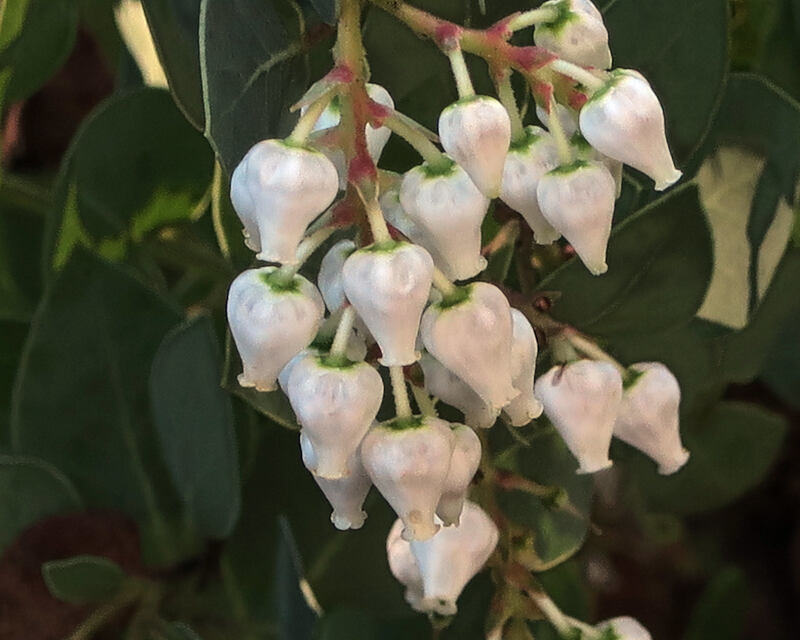
Photo Credit: John Rusk / Flickr / CC BY 2.0
There are several types of manzanita in California, but one of the most popular ones is the big berry manzanita. This shrub grows from the Bay Area down to the border on rocky slopes, flats, desert transition areas, and woodlands. It has light green waxy leaves. Clusters of white or pink bell-shaped flowers bloom in winter and spring. Its berries are the largest of any manzanita.
Big berry manzanita flowers attract bees, butterflies, and hummingbirds. Other birds eat the round red fruits the shrub produces. Humans can also eat these berries. This shrub is drought tolerant almost to a fault. Water it around once a month once established, but be careful — direct water could kill the plant. Big berry manzanita is generally easy to grow but will be more difficult in dry areas like SoCal.
This shrub has an unusual lifecycle. Not only can it live 100 years, but it won’t produce fruit until 20 years in. Even stranger, its seeds won’t germinate unless exposed to fire or sulfuric acid. The easiest way to propagate this plant is from cuttings. Plant it on rocky slopes, but avoid any south-facing slopes in dry areas because it gets too warm. Big berry manzanita is susceptible to leaf galls, though they aren’t severe.
Growth habit: Shrub or small tree
USDA Hardiness Zone: 7-10
Mature size: 3 ⅓ to 20 feet tall and 6 to 20 feet wide
Duration: Perennial
Foliage: Evergreen
Sunlight needs: Full sun
Soil preferences: Fast or medium-draining soils with a pH between 6 and 8
Water needs: Low
Potential hazards: None known
8. Showy Penstemon (Penstemon spectabilis)
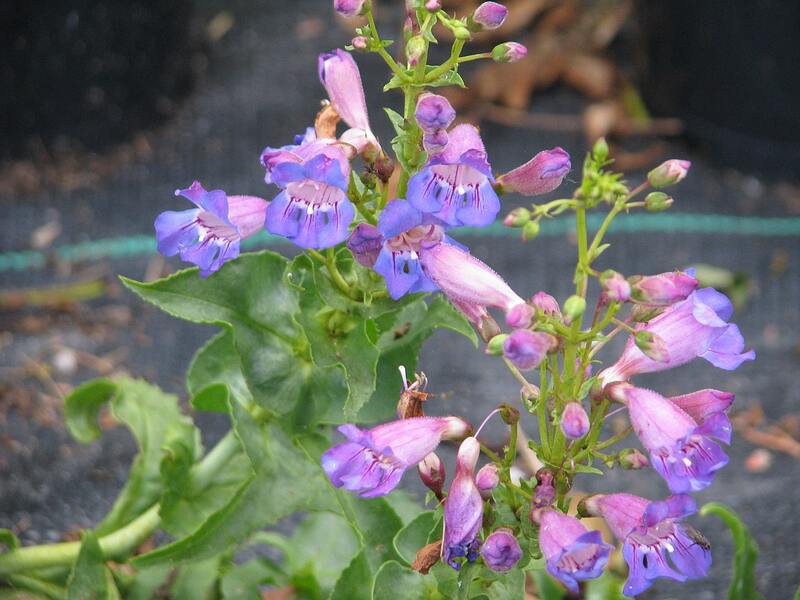
Photo Credit: peganum / Wikimedia Commons / CC BY-SA 2.0
This plant is primarily found in Southern California’s chaparral, scrub, and woodlands. Its leaves grow in pairs on opposite sides of the stem. Within its first year, showy penstemon produces clusters of bluish-purple trumpet-shaped flowers that hummingbirds and wasps pollinate. It flowers in winter and spring.
Showy penstemon is quick-growing and easy to care for. Though it has a relatively short lifespan of five to ten years, its reseeding ability will allow new plants to pop up in your garden. It can handle a variety of soil textures.
The amount of water needed depends on how well the soil retains water. If it retains water well, you may not need to supplement irrigation. You can water showy penstemon once a month for improved flowering, but it may shorten its lifespan. Plant it on a slight slope for improved drainage.
Growth habit: Herb
USDA Hardiness Zone: 8-11
Mature size: 2 to 4 feet tall and 3 to 4 feet wide
Duration: Perennial
Foliage: Evergreen
Sunlight needs: Full sun or partial shade
Soil preferences: Well-drained rocky, loamy, sandy, or clay soils with a pH between 6 and 7.5
Water needs: Very low
Potential hazards: No known danger
9. Toyon (Heteromeles arbutifolia)
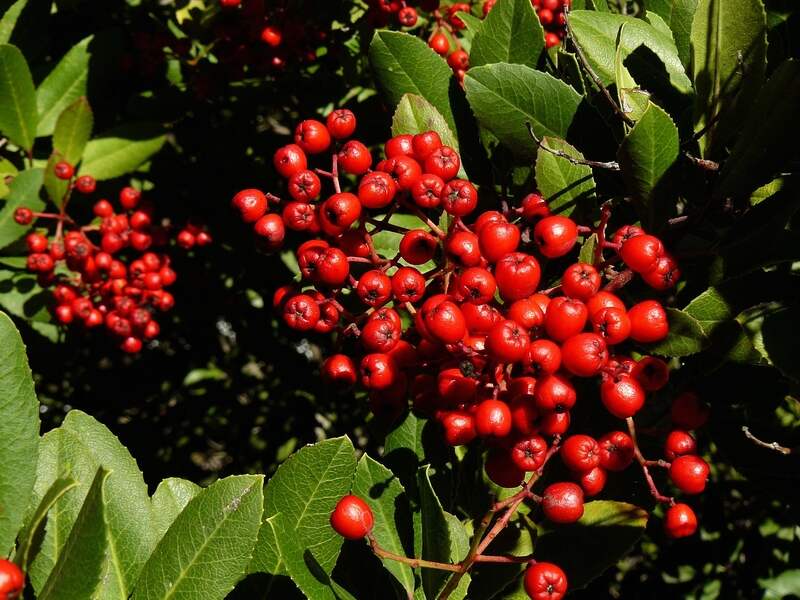
Photo Credit: Pxhere
Also known as Christmas berry or California holly, this shrub is reportedly the namesake of Hollywood. It’s most at home in Western California and the Sierra foothills. It produces small white flower bunches in early summer that release a pleasant smell and attract butterflies and other insects. The red berries produced afterward feed birds and mammals.
Toyon is drought-tolerant and easy to grow. It tolerates more water than other chaparral shrubs and does well near water sources or irrigated areas. The farther south you live, the more they benefit from shade. If you live in a colder part of California, they will tolerate temperatures as low as -5 degrees Fahrenheit. This plant is sometimes used for erosion control.
Toyon berries are edible to humans. However, the unripe berries contain cyanogenic glycosides, which can become cyanide if consumed, similar to apple seeds. Cooking the berries is the safest way to consume them. This plant may not be the best choice for pet owners and parents unless you can supervise their activity carefully.
Growth habit: Shrub
USDA Hardiness Zone: 7
Mature size: 6 to 30 feet tall and 10 to 15 feet wide
Duration: Perennial
Foliage: Evergreen
Sunlight needs: Full sun or partial shade
Soil preferences: Clay, sand, and serpentine soils with a pH between 5 and 8
Water needs: Extremely low
Potential hazards: Edible but poisonous when unripe
How to Choose the Best California Native Plants for Your Landscape
Mountains, deserts, beaches — California has it all. The variety of climates and geographical differences mean a native plant that does well in Southern California might not do well in Northern California. Before choosing a plant, confirm its suitability for your area. USDA hardiness zones are an excellent way to narrow down your choices. California contains zones 6 through 10.
Even within the same city, you may notice differences between your yard and other properties. The soil composition, slope, sun or shade, and presence of water sources can all make conditions more or less favorable. The University of California Cooperative Extensions can recommend commercial soil testing labs to check for pH and nutrient levels.
Don’t forget your garden goals. Do you want sweet-smelling wildflowers to attract bees and butterflies? Do you want to minimize water usage and fire risk? California is home to so many native plants that you should be able to find whatever you’re looking for.
FAQ About California Native Plants
Most California native species are adapted to low-water conditions. However, the following plants are especially drought-resistant:
● California buckwheat
● California sagebrush
● Toyon
If you need to stabilize a bank or reduce the risk of erosion, consider:
● California buckwheat
● California sagebrush
● Common yarrow
● Toyon
Yes. The California Native Plant Society has information on thousands of plant species native to the state. You can sort by a variety of factors to find what you need.
The safest plants for kids and pets won’t have spikes and aren’t poisonous when consumed. Of the plants we’re discussed, the following species don’t pose any known threat to humans or animals:
● California buckwheat
● California fuschia
● Hummingbird sage
● Big berry manzanita
● Showy penstemon
When to Hire a Pro
It takes time and effort to build a native garden. You’ll need to acquire the plants once you narrow your options by location and personal preference. You also can switch to a more suitable turfgrass to make your landscaping more drought-resistant.
A new plant here and there is manageable enough, but a complete yard transformation may be too much to handle with limited free time. Let Wikilawn connect you with a local landscaping company. These pros can help homeowners in Los Angeles, Fresno, San Francisco, and many other cities.
Main Image Credit: Joe Decruyenaere / Flickr / CC BY-SA 2.0